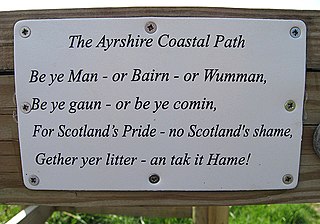This article relies largely or entirely on a single source .(April 2024) |
ABSET was an early declarative programming language from the University of Aberdeen. [1]
This article relies largely or entirely on a single source .(April 2024) |
ABSET was an early declarative programming language from the University of Aberdeen. [1]

Edsger Wybe Dijkstra was a Dutch computer scientist, programmer, software engineer, mathematician, and science essayist.

Lambda is the eleventh letter of the Greek alphabet, representing the voiced alveolar lateral approximant IPA:[l]. In the system of Greek numerals, lambda has a value of 30. Lambda is derived from the Phoenician Lamed. Lambda gave rise to the Latin L and the Cyrillic El (Л). The ancient grammarians and dramatists give evidence to the pronunciation as (λάβδα) in Classical Greek times. In Modern Greek, the name of the letter, Λάμδα, is pronounced.
Logic programming is a programming, database and knowledge representation paradigm based on formal logic. A logic program is a set of sentences in logical form, representing knowledge about some problem domain. Computation is performed by applying logical reasoning to that knowledge, to solve problems in the domain. Major logic programming language families include Prolog, Answer Set Programming (ASP) and Datalog. In all of these languages, rules are written in the form of clauses:

Scottish Gaelic, also known as Scots Gaelic or simply Gaelic, is a Goidelic language native to the Gaels of Scotland. As a Goidelic language, Scottish Gaelic, as well as both Irish and Manx, developed out of Old Irish. It became a distinct spoken language sometime in the 13th century in the Middle Irish period, although a common literary language was shared by the Gaels of both Ireland and Scotland until well into the 17th century. Most of modern Scotland was once Gaelic-speaking, as evidenced especially by Gaelic-language place names.

Extensible Markup Language (XML) is a markup language and file format for storing, transmitting, and reconstructing arbitrary data. It defines a set of rules for encoding documents in a format that is both human-readable and machine-readable. The World Wide Web Consortium's XML 1.0 Specification of 1998 and several other related specifications—all of them free open standards—define XML.
Planner is a programming language designed by Carl Hewitt at MIT, and first published in 1969. First, subsets such as Micro-Planner and Pico-Planner were implemented, and then essentially the whole language was implemented as Popler by Julian Davies at the University of Edinburgh in the POP-2 programming language. Derivations such as QA4, Conniver, QLISP and Ether were important tools in artificial intelligence research in the 1970s, which influenced commercial developments such as Knowledge Engineering Environment (KEE) and Automated Reasoning Tool (ART).
A bracket is either of two tall fore- or back-facing punctuation marks commonly used to isolate a segment of text or data from its surroundings. They come in four main pairs of shapes, as given in the box to the right, which also gives their names, that vary between British and American English. "Brackets", without further qualification, are in British English the (...) marks and in American English the [...] marks.
Absys was an early declarative programming language from the University of Aberdeen. It anticipated a number of features of Prolog such as negation as failure, aggregation operators, the central role of backtracking and constraint solving. Absys was the first implementation of a logic programming language.
The vertical bar, |, is a glyph with various uses in mathematics, computing, and typography. It has many names, often related to particular meanings: Sheffer stroke, pipe, bar, or, vbar, and others.

Major Roland Edward Elcock VC MM was an English recipient of the Victoria Cross, the highest and most prestigious award for gallantry in the face of the enemy that can be awarded to British and Commonwealth forces.
Akan is a group of several closely related languages within the wider Central Tano languages. These languages are the principal native languages of the Akan people of Ghana, spoken over much of the southern half of Ghana. About 80% of Ghana's population can speak an Akan language as a first or second language, and about 44% of Ghanaians are native speakers. There are populations of polyglots in Ghana who speak an Akan language as a third language. They are also spoken in parts of Côte d'Ivoire.

Caddo is a Native American language, the traditional language of the Caddo Nation. It is critically endangered, with no exclusively Caddo-speaking community and as of 2023 only two speakers who had acquired the language as children outside school instruction, down from 25 speakers in 1997. Caddo has several mutually intelligible dialects. The most commonly used dialects are Hasinai and Hainai; others include Kadohadacho, Natchitoches and Yatasi.
Potawatomi is a Central Algonquian language. It was historically spoken by the Pottawatomi people who lived around the Great Lakes in what are now Michigan and Wisconsin in the United States, and in southern Ontario in Canada. Federally recognized tribes in Michigan and Oklahoma are working to revive the language.

No. 10 Squadron is a Royal Australian Air Force (RAAF) signals intelligence (SIGINT) squadron based at RAAF Base Edinburgh, South Australia. It is part of No. 92 Wing RAAF. The squadron was formed in 1939 as a maritime patrol unit. It saw active service during the Second World War, conducting anti-submarine operations and patrols from bases in the United Kingdom until it disbanded in late 1945. It was re-formed in Australia in 1949 and since then has contributed to Australia's East Timor intervention, and has been deployed to the Middle East as part of the War on Terrorism and the 2003 Gulf War. Most recently it now has a signals intelligence mission.

Programming language theory (PLT) is a branch of computer science that deals with the design, implementation, analysis, characterization, and classification of formal languages known as programming languages. Programming language theory is closely related to other fields including mathematics, software engineering, and linguistics. There are a number of academic conferences and journals in the area.
A deductive language is a computer programming language in which the program is a collection of predicates ('facts') and rules that connect them. Such a language is used to create knowledge based systems or expert systems which can deduce answers to problem sets by applying the rules to the facts they have been given. An example of a deductive language is Prolog, or its database-query cousin, Datalog.

The Appendix Probi is the conventional name for a series of five documents believed to have been copied in the seventh or eighth century in Bobbio, Italy. Its name derives from the fact that the documents were found attached to a copy of the Instituta Artium, a treatise named after the first-century grammarian Marcus Valerius Probus.
The 1888 Home Nations Championship was the sixth series of the rugby union Home Nations Championship. Three matches were played between 4 February and 10 March. It was contested by Ireland, Scotland and Wales. England were excluded from the Championship due to their refusal to join the International Rugby Football Board.

Modern Scots comprises the varieties of Scots traditionally spoken in Lowland Scotland and parts of Ulster, from 1700.

HGTV is an American basic cable channel owned by Warner Bros. Discovery. The network primarily broadcasts reality programming related to home improvement and real estate.
This article needs additional or more specific categories .(November 2024) |